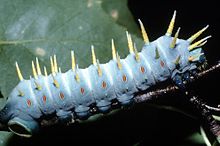Coscinocera hercules
| Coscinocera hercules | ||||||||||||
|---|---|---|---|---|---|---|---|---|---|---|---|---|

Coscinocera hercules , male on cocoon |
||||||||||||
| Systematics | ||||||||||||
|
||||||||||||
| Scientific name | ||||||||||||
| Coscinocera hercules | ||||||||||||
| ( Miskin , 1876) |
Coscinocera hercules , sometimes also called Hercules moth , is a butterfly ( moth ) from the family of peacock moths (Saturniidae)that occurs in New Guinea and Australia. The specific epithet of this very large and impressive species was chosen after Hercules , an equally stately figure from Greek mythology .
description
butterfly
The moths reach a wingspan of up to 200 millimeters for the males and up to 270 millimeters for the females. In addition to the Atlas moth ( Attacus atlas ), they have the largest wing surface of all known butterfly species. There is a clear sexual dimorphism between the sexes . In the males, the shape of the front wings is clearly sickle-like. The basic color of the upper sides is maroon, slightly lightened at the apex . The yellowish, mostly interrupted outer transverse line continues on the hind wings. Pointed discal spots stand out on all wings. The hind wings are provided with long narrow tails. The females are predominantly light red-brown, gray-brown or yellow-brown in color and show large, light discal spots. The forewings are only slightly sickle-shaped, the hind wings have short butt rounded tails. The undersides of all wings show similar drawing elements as the upper sides in a slightly weakened form. The males have very large and strongly combed antennae . With this they ingest the pheromones emitted by the females .
Caterpillar
Young caterpillars are whitish in color, black stripes and have strongly branched thorns on all body segments. Adult caterpillars have a light blue basic color, on each body segment reddish tracheas and thin yellow protuberances (scoli).
Distribution and occurrence
Coscinocera hercules is found locally in Papua New Guinea and Far North Queensland . The species prefers to colonize tropical deciduous forests.
Way of life
The moths can be found in several generations throughout the year. They do not eat any food. After mating, the females lay the eggs in groups on the leaves of the forage plant. A female can produce up to 300 eggs, from which the caterpillars hatch after 14 days. They go through six moults before they are fully grown and then reach a length of 12 centimeters. The caterpillars feed on the leaves of various deciduous tree species, including: Dysoxylum muelleri , Glochidion ferdinandi , Homalanthus nutans and Timonius singularis To pupate , the caterpillar spins itself in a cocoon made of silk.
Individual evidence
- ↑ Gene Kritsky, Ron Cherry: Insect Mythology. Writers Club Press, USA, 2000, ISBN 978-0-595-15017-5
- ↑ JCU Australia: Coscinocera hercules , James Cook University , Townsville / Cairns, Australia. (viewed at https://www.jcu.edu.au/discover-nature-at-jcu/animals/butterflies-and-moths-by-scientific-name/coscinocera-hercules on October 15, 2017).
- ↑ occurrence
- ↑ development
- ↑ Food plants
Web links
- aus-lep.com - adults and first stands
- Lepiforum e. V. - photos
- zoodirektoren.de ( Memento from April 6, 2016 in the Internet Archive ) - Pfauenspinner
- silkmoths.eu - silk moth
- eol.org - Encyclopedia of Life

